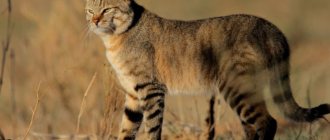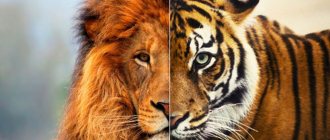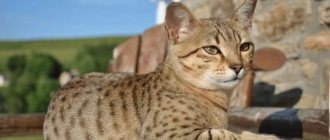- Wild animals
- >>
- Mammals
Mountain Lion - This cat has more names than any other mammal. But no matter what you call it, it’s the same cat, Puma concolor, the largest representative of small cat species. Why does he have so many names? Mainly because it has such a large habitat and people from different countries call it by their own name.
Origin of the species and description
Photo: Mountain Lion
The mountain lion is a large, graceful cat belonging to the cat family. They are also called cougars, panthers and pumas. Although mountain lions are big cats, they are not classified under the "big cat" category. Instead, they are one of the largest cats in the "small cat" category, although some can match the size of a leopard.
Video: Mountain Lion
One of the most obvious reasons why this large and powerful feline is not classified as one of the "big" cats in the world is that the mountain lion cannot roar. Mountain lions' powerful hind legs are so muscular that they not only allow them to pounce on their prey and ensure their safety, but are also capable of jumping great distances.
One of the most famous subspecies of cougar is the Florida Panther, which is the smallest of the cougar species, as well as the rarest. Considered critically endangered, this endangered animal has a more reddish tint to its fur on its back along with a dark spot in the center.
Fun fact: The scientific name Puma concolor is a little confusing because it's not entirely accurate. Concolor means "of one color," but this is not entirely true: young mountain lions are indeed one color, while adults have a mixture of shades, with an overall hue ranging from gray to rust.
Puma and man
Theodore Roosevelt created a society for the protection of animals, but for some reason he disliked pumas and (with the support of the head of the Zoological Society of New York) allowed them to be exterminated throughout the country with impunity. It didn’t take long to persuade the hunters, and hundreds of thousands of cougars were destroyed in America, despite the fact that the beast itself avoids humans and attacks them extremely rarely . In total, there were less than a hundred recorded cougar attacks in the United States and Canada (from 1890 to 2004), most of which occurred on the island. Vancouver.
In puma habitats, basic precautions must be taken:
- keep an eye on children;
- take a strong stick with you;
- do not move alone;
- when threatened, you should not run away from a puma: you need to look it straight in the eye and... howl.
It has been proven that the beast is afraid of tall people. As a rule, the targets of its attacks are children or short adults crossing the cougar's path at night.
Return to content
Appearance and features
Photo: What a mountain lion looks like
Mountain lions have similar body types to domestic cats, just on a larger scale. They have slender bodies and round heads with pointed ears. They vary between 1.5-2.7 m from head to tail. While males can weigh up to 68 kg, females weigh less, peaking at around 45 kg.
Mountain lions are well built, have large paws and sharp claws. Their hind legs are larger and more muscular than their front legs, giving them greater jumping power. Mountain lions can leap 5.5 meters from the ground into trees, and are capable of jumping 6.1 meters up or down a hill, which is the height of many two-story buildings. Mountain lions are also capable of running fast and have a flexible spine like a cheetah, which helps them move around obstacles and change direction quickly.
The mountain lion's coat is grayish-brown to slightly reddish in color with lighter areas on the underside. The tail has a black spot at the end. The muzzle and chest are white, with black markings on the face, ears and tip of the tail. Mountain lion kittens have black spots until they are about 6 months old.
Geographically and seasonally, the shade of brown varies from gray to reddish brown, and some black cougars have been reported. The color patterns on the face can also vary. The underside is lighter than the top. The long tail is often colored black and is usually held close to the ground when the mountain lion walks.
The lower jaw is short, deep and powerful. The carnassial teeth are massive and long. The fangs are heavy and compressed. The incisors are small and straight. Mountain lions have another small premolar on each side of the upper jaw, unlike bobcats.
Fun fact: Mountain lion tracks are made by four toes on the front paw and four toes on the back paw. Retractable claws do not appear on prints.
Natural enemies
The puma has practically none of these. With some stretch, its natural enemies include such large predators as:
- jaguars;
- wolves (in packs);
- grizzly;
- black caimans;
- Mississippi alligators.
This is interesting! The puma stoically endures the torture of a trap (unlike the maddening jaguar and tiger). She makes several attempts to free herself, after which she resigns herself to her fate and sits motionless until the hunter arrives.
All of these animals usually attack weakened or young cougars. One of the enemies of the puma is the person who shoots and sets traps for it.
Return to content
Where does the mountain lion live?
Photo: American mountain lion
The mountain lion is believed to be one of the most adaptable felines, as they are found in a variety of habitats. However, with the expansion of human settlements and the clearing of land for agriculture, the mountain lion is being pushed into smaller pockets of its historically large territory, retreating into a more hostile mountain environment that is further away from people. There are six subspecies of mountain lions, distributed in areas such as:
- South and Central America;
- Mexico;
- Western and North America;
- Florida.
Mountain lions tend to roam in areas where they would not be seen, such as rocky mountains or dark forests. They usually do not attack people unless they feel cornered or threatened. Most of the mountain lion population can be found in western Canada, but it has also been spotted in southern Ontario, Quebec and New Brunswick. Mountain lions are important as top predators in the ecosystems in which they live. They help control populations of large ungulates.
Although mountain lion attacks on humans are extremely rare, they have been on the rise in the last few decades. As with most livestock killings, a mountain lion that attacks a human is usually a starved animal that has been pushed into marginal habitat by more dominant males.
But it is human encroachment into mountain lion territory that creates marginal mountain lion habitat. The more people vacation and live in rural areas, the higher the likelihood of encountering these secretive animals. However, by taking some precautions, humans and mountain lions can coexist.
Now you know where the mountain lion is. Let's see what this wild cat eats.
Habitat
These cats boast the most extensive habitat. They inhabit the North American continent, are found in Central American countries, and are found in almost all regions of South America.
Cougars inhabit most countries of both American continents
The natural habitat of pumas extends from the southern regions of Canada to the Rocky Mountains of the United States. They are found in northeastern Mexico, Nicaragua, Costa Rica, Guatemala and Panama. On the South American continent, pumas live in areas ranging from northern latitudes to the pampas of Patagonia.
Pumas have an amazing ability to adapt to any living conditions with different landscapes. They live in cold coniferous forests and in the hot tropics. They live in wetlands and grassy plains. Cougars can be found in the high mountain regions of the United States and Canada, and in the arid South American pampas.
What does a mountain lion eat?
Photo: Mountain lion from the Red Book
Mountain lions hunt over a large area, and it can take one member of the species a week to roam an entire home. Mountain lions eat different prey depending on where they live. Basically, a mountain lion will eat any animal it can catch, even ones as big as elk.
Their food can be:
- deer;
- pigs;
- capybaras;
- raccoons;
- armadillos;
- hares;
- proteins.
Mountain lions love to hunt deer, although they also eat smaller animals such as coyotes, porcupines and raccoons. They usually hunt at night or during the dark hours of dawn and dusk. These cats use a mixture of stealth and strength to hunt. A mountain lion will stalk its prey through bushes and trees and over rock ledges before powerfully leaping onto the victim's back and delivering a suffocating bite to the neck. The puma's flexible spine is adapted for this killing technique.
When large prey dies, the mountain lion is known to cover it with bushes and return to feed within a few days. They subsidize their diets with large insects and small rodents. Annual food consumption ranges from 860 to 1,300 kg of large carnivores, about 48 ungulates per mountain lion per year.
Fun Fact: Mountain lions have particularly keen eyesight and are most likely to locate prey by watching it move. These cats hunt most actively at dusk or dawn.
Features of character and lifestyle
Photo: Mountain lion in winter
Mountain lions are territorial animals, and territory depends on terrain, vegetation, and the abundance of prey. Mountain lions avoid areas where there are human settlements. Women's territories tend to be half of men's territories.
Mountain lions are most active at dawn and dusk. Mountain lions are ambush predators, meaning they depend on stealth and the element of surprise to catch their prey—primarily deer and elk, sometimes porcupine or elk, and sometimes smaller species like raccoons. rabbits, beavers or even mice.
They inhabit large areas, which are usually oval or round in shape. The area of intimidating territories and their numbers depend on the abundance of prey, vegetation and terrain. If there is a shortage of production in a particular area, the size of individual territories will be large. They do not have permanent dens, but are found in caves, rocky outcrops, and dense vegetation. Mountain lions tend to migrate to the mountains during the winter, primarily for hunting purposes.
Mountain lions are vocal cats that are well known for their low hisses, growls, purrs and calls. Because they have the largest hind legs in the cat family, mountain lions can jump very high - up to 5.4 meters. Horizontal jumps can measure from 6 to 12 meters. They are very fast cats and are also good climbers and can swim.
Mountain lions rely primarily on sight, smell, and hearing. They use low hisses, growls, purrs and screams in a variety of circumstances. Loud, whistling sounds are used to call the mother. Touch is important in the social bond between mother and calf. Scent marking is important within the boundaries of territory designation and reproductive state.
Social structure and reproduction
Photo: Mountain lion in nature
A mountain lion in the wild will not mate until it has established a home territory. Mountain lions begin breeding at around 3 years of age. Like many other felines, mountain lion cubs are born blind and completely helpless for the first two weeks of life until their blue eyes open fully.
The cubs are separated from their mother after 2-3 months. Newborn mountain lions have spots that help them blend in with the grass and dappled sunlight. Their eyes also change from blue to yellow by the time they are 16 months old.
By 18 months, young cats leave their mother to fend for themselves. Their mother feeds them for about 3 months, but they begin to eat meat at about 6 weeks. At 6 months, their spots begin to fade and they are trained to hunt. The cubs live with their mother for up to 12-18 months.
Mountain lion cubs are more vicious than the cubs and kittens of many other cats - they are untamable from birth, and all attempts to befriend a mountain lion seem to have failed. Mountain lions are wild animals in an unusual sense, and they apparently cannot be domesticated to any degree.
Mountain lions breed year-round, but breeding season typically occurs between December and March. Female mountain lions typically give birth every two years. In the wild, a mountain lion can live up to 10 years. In captivity they can live up to 21 years.
Natural enemies of mountain lions
Photo: Mountain Lion in America
For the most part, the mountain lion has no natural predators and is at the top of the food chain. However, they sometimes compete with other predators such as bears and wolves for food. Wolves pose a real threat to mountain lions, either directly or indirectly. Wolves rarely eat kittens that they kill, suggesting that they kill to eliminate competition. And while the wolves haven't killed the adult mountain lions, they seem to stalk them at every opportunity.
The biggest threat to the mountain lion is habitat loss. As people move deeper into its habitat, not only for housing and ranching but also for recreational activities, mountain lions have difficulty establishing enough hunting territories without risking encounters with humans. This is when this predator becomes prey for trophy hunting, livestock protection and the general safety of pets and sometimes children.
The most significant cause of mortality for mountain lions is hunting, which accounts for nearly half of adult deaths. The first mountain lion hunting season was established in 2005 as an “experimental season,” and the season continues to be used as a tool to manage mountain lion populations at desired levels.
Reproduction and raising of offspring
Sexual maturity in female pumas occurs when they reach 2 years of age. Males are ready to reproduce by the age of 3, and only after they have acquired their own territory.
Mountain lions do not have a specific breeding season; they can mate throughout the year. But for pumas living in northern regions, where winters are snowy and harsh, the mating season begins in December and lasts until March, so that kittens are raised in more favorable warm conditions.
Features of the mating season of pumas
The whole district knows that cougars have begun mating games. After all, usually quiet and calm cats, in search of a mate, fill the surroundings with heartbreaking sounds, similar at the same time to the cry of a child and the howl of an entire wolf pack. Females use such cries to signal their readiness to mate. Well, the males try to intimidate their rivals with loud screams and attract the attention of potential partners.
But males are not limited to “love serenades”. They arrange real fights among themselves for the right to own a female, although their matchups are more likely of a ritual nature. In such battles, males do not try to inflict as much damage as possible on their competitor, and rarely use their teeth and claws. Their fights boil down to the fact that the males, having met on the battlefield, try to “outshout” each other, and victory remains with the one with the loudest and most sonorous voice.
Couple of mountain lions in love
The relationship between the female and the male is very reverent and tender, they communicate with quiet meows and express their affection with affectionate touches. The couple spends about a day together, after which the male goes in search of other mating partners, while the females, after mating, do not allow other males to approach them. Paternal feelings are not inherent in males, and care for future offspring falls entirely on the shoulders of females.
Population and species status
Photo: What a mountain lion looks like
Currently, mountain lions are primarily found west of 100°W (roughly central Texas to Saskatchewan), with the exception of southern Texas. Information about Central and South America is lacking, although it is believed that the habitats most suitable for mountain lions exist there.
While there is no exact estimate for the global mountain lion population, it is believed that there are approximately 30,000 individuals in the American West. Densities can range from 1-7 mountain lions per 100 km2, with males carrying multiple females within their home range.
Today, white-tailed deer populations have recovered across much of the cougar's former range, with several animals appearing in more eastern states such as Missouri and Arkansas. Some biologists believe these big cats could eventually reclaim much of the Midwest and East—if people let them. In most western US states and Canadian provinces, the population is considered stable enough to support sport hunting.
Mountain lions are classified as "endangered." The total breeding population of mountain lions is less than 50,000 and continues to decline. They have no particular threats from animals other than humans, although they do interact with other large predators, such as the brown bear and gray wolf, with whom they compete for prey. When the range of mountain lions and jaguars overlaps, the jaguars will dominate larger prey and the mountain lion will take smaller prey.
Puma: general characteristics
These animals belong to the class of carnivorous mammals and are members of the cat family. They are representatives of the puma genus, in which, in addition to the cougars themselves, there are also jaguarundi - unique cats that live in Central and South America. Pumas are considered the fourth largest wild cat, behind jaguars, lions, tigers and leopards in size.
Pumas are very strong and powerful predators.
This is interesting: in the course of numerous studies of morphological features and DNA cells, scientists found that the closest relative of pumas is the cheetah, so both animals were classified as members of the family of small cats.
Pumas have an elongated flexible body, powerful, muscular legs and a long tail covered with thick hair. The height of adult individuals ranges from 60 to 90 cm, and they weigh 60-110 kg. Females differ from males in smaller size, their height does not exceed 80 cm, and they weigh between 60 - 80 kg.
Mountain lions have short, but thick and dense coats. The color is uniform, sand or light brown, with a gray or red tint. The fur in the throat, chest and belly area is lighter, sometimes even white. A distinctive feature of pumas is the dark markings on the face, which contrast beautifully with the main background, and create the impression that the animal is wearing a mask or light makeup.
Pumas are extremely fast and agile, but like cheetahs, they lack stamina. These cats can reach speeds of up to 65 km per hour, but only on flat terrain, and they are not able to maintain this pace for a long time. But a puma in a jump is a truly unforgettable sight! The predator makes jumps up to 7.5 meters in length, up to 4.5 meters in height, but the most amazing thing is that they can jump from a cliff 18 meters high, land elegantly and pounce on prey with lightning speed.
In the wild, pumas live no more than 10-13 years. In captivity, their lifespan increases to 18-20 years.
Elena
Ask a Question
Question to the expert
Do cougars hunt humans?
No, these predators do not consider humans as potential prey. A cougar can attack a person in extreme cases: when it is exhausted from hunger, wounded, or when it has to defend its life. It also happens that at the sight of a fast running person, their hunting instincts are triggered, and the animal knocks down the two-legged prey with a powerful jump. Therefore, zoologists advise everyone who goes for a walk in puma habitats to behave calmly and restrainedly, so as not to provoke the cat to attack.











